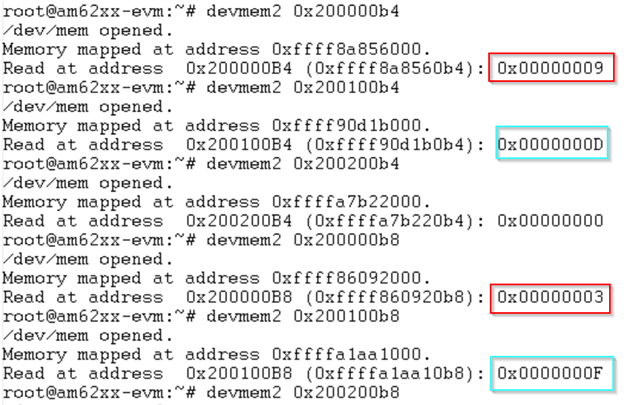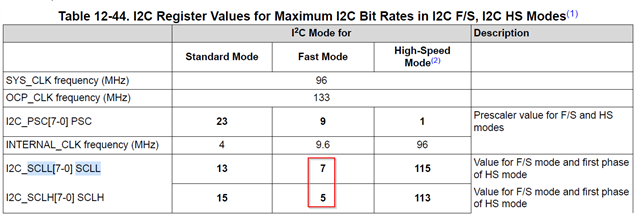Tool/software:
According to TRM, in 400KHz fast mode, SCLL=7, SCLH=5, but read back register SCLL=9, SCLH=3. From SDK8.3 and SDK9.2.
While standard 100KHz configuration is same as TRM.


In SDK11.0, configured I2C2 to fast mode with wrong value also.
root@am62xx-evm:~# devmem2 0x200000b4
/dev/mem opened.
Memory mapped at address 0xffffa9bb3000.
Read at address 0x200000B4 (0xffffa9bb30b4): 0x00000009
root@am62xx-evm:~# devmem2 0x200100b4
/dev/mem opened.
Memory mapped at address 0xffff89f3d000.
Read at address 0x200100B4 (0xffff89f3d0b4): 0x0000000D
root@am62xx-evm:~# devmem2 0x200200b4
/dev/mem opened.
Memory mapped at address 0xffffbef3a000.
Read at address 0x200200B4 (0xffffbef3a0b4): 0x00000009
root@am62xx-evm:~#
root@am62xx-evm:~# devmem2 0x200000b8
/dev/mem opened.
Memory mapped at address 0xffffb340d000.
Read at address 0x200000B8 (0xffffb340d0b8): 0x00000003
root@am62xx-evm:~# devmem2 0x200100b8
/dev/mem opened.
Memory mapped at address 0xffff840d5000.
Read at address 0x200100B8 (0xffff840d50b8): 0x0000000F
root@am62xx-evm:~# devmem2 0x200200b8
/dev/mem opened.
Memory mapped at address 0xffffb30b8000.
Read at address 0x200200B8 (0xffffb30b80b8): 0x00000003
root@am62xx-evm:~#


